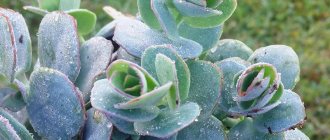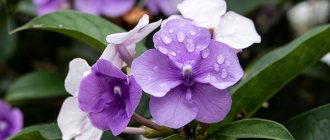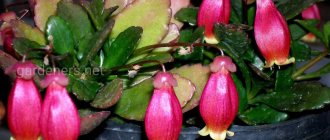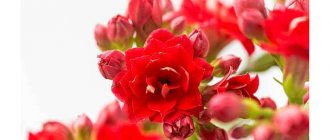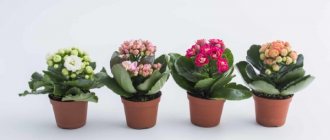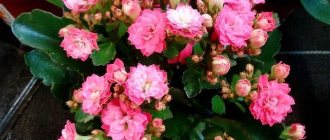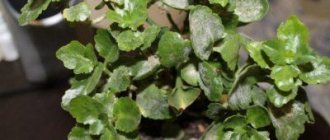Author: Elena N. https://floristics.info/ru/index.php?option=com_contact&view=contact&id=19 Category: Houseplants Published: July 30, 2013Last edits: November 30, 2020
- Kalanchoe bentii / Kalanchoe bentii
Kalanchoe care briefly, table
Kalanchoe is a popular indoor flower. Many varieties of this perennial bloom profusely and are distinguished by a variety of bud colors.
Achieving flowering can be quite simple, because Kalanchoe is famous for its low maintenance requirements. The main thing is to follow the simple rules that you will find in the table below.
| Type of care | How to care |
| Watering | The culture needs moderate watering. It is necessary to water at the root as the top layer of soil dries. Watering should not be frequent, as Kalanchoe tolerates drought well. |
| Illumination | Needs bright, indirect light |
| Temperature | In summer, you need to maintain a temperature regime of 18-22 degrees. In winter, the temperature drops to 15-16 degrees. To stimulate flowering, Kalanchoe should be moved to a cool and dark place for a couple of weeks to form flower buds. |
| Feeding | It responds well to fertilization every 10 days during the active growing season. It is recommended to choose complex nutrients. |
| Trimming | It is recommended to trim off faded buds. Regular decorative pruning is also recommended to give the plant a neat shape. The cut parts can be rooted. |
| Air humidity | Grows equally well at almost any air humidity |
In order for Kalanchoe to regularly form buds and bloom profusely, it is recommended to transplant it into a new substrate once a year at the initial stage of cultivation.
NOTE! Kalanchoe has a number of beneficial properties. Kalanchoe Degremona leaves have antimicrobial and anti-inflammatory properties and are used to combat runny nose and colds.
Botanical description
Kalanchoe (lat. Kalanchoe) - depending on the species, they can be herbaceous perennials, subshrubs or succulent plants. In total, more than 200 species of Kalanchoe are known, and the genus itself is part of the Tolstyankov family. Natural habitat - tropical zones of Australia, Asia and America. The leaves of different species differ from each other. Usually thick, may be strongly or weakly dissected, may be sessile, or may have a petiole. Red, white, yellow or purple flowers are collected in umbrella-shaped inflorescences. Almost all types of Kalanchoe tolerate growing indoors well. The main thing is to follow the recommendations for caring for Kalanchoe at home.
How to care for Kalanchoe in a pot after purchase
The variety of Kalanchoe varieties makes it popular for growing in houses and apartments.
It can not only be purchased in specialized flower shops, but also grown from just one leaf taken from a friend.
You need to care for the purchased Kalanchoe as follows.
- To begin with, the flower must be left in quarantine for several days to make sure that it is not sick and there are no pests on it.
- Then the plant is transplanted into a new substrate. The plant in the flower shop is often fed so that it does not lose its presentation. This can negatively affect the root system. Therefore, after purchase, the plant is transplanted into a new nutrient substrate.
- Watering is carried out only after the top layer of soil has dried.
- After purchase, fertilizers are not used during the first 10 days. As mentioned above, the flower in the flower shop was already overfed.
- If you bought Kalanchoe in the summer, then once a week it will be useful to spray it with warm water.
Store-bought flowers very often start to hurt at home. This is due to adaptation: a change of place, a new environment and microclimate. But if you properly care for the plant, the process of getting used to the new growing conditions will go quickly.
Folk signs
By the appearance of deer antlers you can judge the attitude of strangers towards your home. If after the guest leaves the plant begins to wither, it means that the person is hostile to the owners. If the bush is completely destroyed, it is also going to harm you.
It is better not to give this succulent to newlyweds, as the couple will start having quarrels and misunderstandings. And for a married couple with many years of experience living together, a flowerpot with this Kalanchoe will come to the court, strengthening and refreshing the relationship.
Conditions for keeping Kalanchoe
Growing Kalanchoe at home is not difficult if you provide it with suitable maintenance.
Lighting for Kalanchoe
Kalanchoe loves bright but diffused sunlight. If you place it on a south window, you will have to shade it in the summer.
The ideal place for a flower is a south-east window.
In winter, you may need additional lighting with special phytolamps, but this is not at all necessary, especially if your flower will be in a dormant period during the winter months.
Temperature regime for a flower
Kalanchoe in an apartment quickly adapts to changes in temperature. In order for the crop to bloom constantly and luxuriantly, it is advisable to maintain a temperature of 18 - 22 degrees in summer and 15 - 16 in winter.
Air humidity
Although Kalanchoe develops well at almost any air humidity, it still loves high humidity.
Therefore, in summer it is advisable to spray the flower with water, or place a container with liquid on the windowsill.
ON A NOTE. In principle, you can take care of it in the same way in winter, since heating radiators dry out the air greatly. But, in general, Kalanchoe is hardy enough to survive dry air.
Location and where is the best place to put Kalanchoe
Kalanchoe does not have any special preferences for location in an apartment or house.
It is desirable that the flower receives the right amount of light. In summer you can place it on eastern window sills. In winter, Kalanchoe is placed on the sunny south side. This placement allows you to receive the right amount of light.
ON A NOTE. Kalanchoe thrives equally well in the bedroom, family room, living room and kitchen.
Soil for Kalanchoe, what kind of soil is needed
Kalanchoe does not have any special requirements for soil type. The flower feels good in ordinary flower soil.
You can also prepare the substrate yourself.
To do this you will have to perform the following algorithm of actions:
- mix leaf soil and peat in equal proportions;
- add 1 part of coarse river sand;
- heat the resulting mixture in the oven at a temperature of 70 degrees.
An important point is that the soil must have good aeration, that is, it must be saturated with oxygen. In heavy, oily soil, the plant feels worse.
How to choose a flower pot
The size of the pot depends on the size of the root system of a particular specimen. Experts recommend planting in small pots, since Kalanchoe grows quickly and branches heavily. This affects the decorative qualities of the plant. In addition, small specimens look neat and are easier to care for.
Typically, containers 3-4 cm larger than the roots are selected for transplantation. As the root system grows, the Kalanchoe must be replanted again and again.
Watering and lighting
Before watering, you should make sure that the top layer of soil has dried a few centimeters. In winter, reduce the number of waterings to once a month. For irrigation, use settled water at room temperature. During watering, water should not get on the leaves and inflorescences, otherwise the bush may rot.
In summer, it is recommended to keep the flower on windows on the south or east side. When the sun is very hot, the succulent must be shaded so that it does not get sunburn. In winter, the crop can be grown on a south-facing window.
Caring for Kalanchoe
As mentioned above, Kalanchoe is not at all demanding to care for. It tolerates drought and bright sunlight well, takes root easily and grows quickly.
But, if you want your flower to grow strong, healthy, bloom lushly and regularly, it is better to provide the plant with suitable conditions for growth.
Features of watering Kalanchoe
In summer, Kalanchoe needs frequent watering. It is advisable to water every 3-4 days, since in summer the soil will often dry out. Try to pour water carefully so as not to get on the leaf plates.
In winter, care must be taken differently: watering is reduced to once a week.
IMPORTANT! Settled water is used for irrigation.
More information about watering Kalanchoe
Application of fertilizing and fertilizers
Kalanchoe will also need fertilizers. Especially during the active spring-summer growing season.
It is better to use liquid complex mixtures with equal contents of potassium, nitrogen and phosphorus. You can use specialized mixtures for succulents.
You can adhere to this fertilizer application schedule.
- in summer it is recommended to feed the crop with complex fertilizers every 10 days;
- in spring, the frequency of fertilization is every 15 days;
- in autumn, fertilizing is reduced to 1 time every 20 days;
- In winter you don’t have to feed it, as Kalanchoe goes into a dormant state.
Too intensive feeding during the dormant period can lead to buds starting to form prematurely and the plant becoming weak.
Spraying
A common problem in caring for Kalanchoe is dry air in apartments. This is especially evident in winter, when central heating pipes and radiators literally dry out the room.
Of course, Kalanchoe can grow in the dry microclimate of an apartment, but it is still advisable to maintain a slightly increased level of air humidity around the crop.
Therefore, Kalanchoe is sprayed with water from a spray bottle.
Spraying in summer is carried out once a week. Warm, settled water is used for spraying. This method of moistening also allows you to saturate with moisture and wash away dust from the sheet plates.
In winter, spraying is reduced to 1 time every 2 weeks. It is carried out so that the leaves do not lose their elasticity and rich color.
NOTE! Spraying too frequently can lead to fungal infections.
Trimming
It is important to prune in a timely manner. After the buds fade, you need to carefully trim the flower stalks.
It is also advisable to carry out sanitary pruning, removing damaged shoots.
Since Kalanchoe is a fast-growing crop, in one season the plant grows quite a large green mass. It doesn't always look neat.
Therefore, experienced gardeners recommend regular decorative pruning. In this case, the cut parts of the plant can be rooted and new specimens obtained.
Transplanting Kalanchoe into a new pot
It is recommended to transplant young specimens into a new container every year. For adult bushes, replanting is carried out every 2-3 years.
If the plant is blooming and an emergency transplant is required, you need to carefully transplant the bush into a new container, which will be several centimeters larger than the previous one, using the transfer method.
It is recommended to replant in early spring (March). During the transplantation period, you need to carefully inspect the roots and, if necessary, cut off damaged ones.
Kinds
Kalanchoe bentii / Kalanchoe bentii
This Kalanchoe is native to the Arabian Peninsula. The species is represented by powerful subshrubs that grow up to 1 m in height. The leaves are thick and long - almost up to 0.5 m, round in shape, growing in six pairs. White flowers grow on an umbrella-shaped inflorescence. Flowering period mid to late spring. Feels best in cool rooms.
Kalanchoe beharensis / Kalanchoe beharensis
Lives in the south of Madagascar. The species is represented by shrubs. The shoots of this species become bare from below over time. The leaves are covered with hairs; the edge of the leaf can be solid or slightly jagged. The flowers are less than 1 cm long and also pubescent.
- Tips for caring for Christmas
Kalanchoe blossfeldiana
Habitat: Madagascar island. The species is represented by erect, low shrubs - up to 30 cm in height. The leaves are green with red edges, ovoid in shape (length - 7 cm, width - 4 cm), not pubescent. The flowers are red, erect, and collected in umbrella-shaped inflorescences. The usual flowering period is from late winter to early summer. Forms with orange, yellow, white, pink and other flowers have been developed.
Kalanchoe tomentosa
Lives in Madagascar. The species is represented by subshrubs. The shoots are pubescent and erect. The leaves are sessile, elongated-ovate (up to 6 cm long and up to 1.5 cm wide), the edge is smooth. Small flowers grow on an umbrella-shaped inflorescence.
Kalanchoe daigremontiana
Habitat: Madagascar. This species is a herbaceous perennial that grows up to 0.5 m in height. The leaves are variegated from top to bottom. The upper part of the leaf is gray-green, the edges are uneven, not pubescent, elongated-elliptical in shape (up to 10 cm long). The leaves are covered with purple spots. The inflorescence is a panicle. Corolla tube up to 1.5 cm long, petals up to about 5 mm long, pink. Flowering period is winter.
Kalanchoe grandiflora
Also known as Kalanchoe marmorata. This genus is from India, a subshrub slightly more than 0.5 m in height. The leaves are green (may become reddish over time if the flower is in the sun), coarsely toothed. Petioles are short. The flowers are pale yellow, collected in umbrella-shaped inflorescences. The flowering period is May, it smells very nice.
Kalanchoe manginii / Kalanchoe manginii
This is an ampelous species of Kalanchoe that is very similar to Kalanchoe Blossfeld, but differs in having larger flowers that droop rather than being erect. The flowering period usually occurs in spring.
Kalanchoe paniculata / Kalanchoe thyrsiflora
These are tall herbaceous perennials (up to 60 cm tall). The leaves are egg-shaped, tapering towards the base, up to 15 cm long and up to 7 cm wide. The leaves grow densely at the base and the higher they are, the rarer and smaller new silvery-white leaves grow. It blooms at the end of spring with yellow flowers up to 1.5 cm long, petals up to 5 mm in diameter. It reproduces well by children that appear after flowering.
Marbled Kalanchoe / Kalanchoe marmorata
This species has many names and is also known as Kalanchoe grandiflora and Kalanchoe somaliensis. Grows in the mountains of Ethiopia. These are Kalanchoe - half-meter shrubs. The leaves are green (grey over time) covered with lilac or brown spots. The leaf shape is ovoid, but the leaf tapers at the base and has indentations along the edge. White flowers are collected on an umbrella-shaped inflorescence. The corolla tube is up to 8 cm long, the petals have the shape of an elongated egg.
Kalanchoe pinnata / Kalanchoe pinnata
Homeland - Madagascar. Tall herbaceous perennials - reach 1 m in height. The leaves on the same plant are different from each other. The lower leaves are simple, usually ovate with a heart-shaped base, while the lower leaves are pinnate, with three to five leaflets. Leaf color is green. The corolla tube is white-green, and the petals are reddish.
Kalanchoe flammea / Kalanchoe flammea
It can be found under the name Kalanchoe glaucescens. Homeland: Somalia. Low herbaceous perennials that reach a height of 40 cm. The leaves are ovoid, up to 8 cm long and up to 3 cm wide, tapering at the base, widely rounded on the other side, serrated. The flowers are bright red and bright orange, collected in umbrella-shaped inflorescences. The petals are up to 2 cm in diameter, the corolla tube is slightly expanded.
Kalanchoe tubiflora
Originally from Madagascar. This species is a tall subshrub or herbaceous perennial, growing up to 70 cm in height. The leaves are narrow, green with a gray tint and covered with brown spots, reaching up to 12 cm in length. The corolla tube is up to 2.5 cm long, red.
Kalanchoe dissected (lobed) / Kalanchoe laciniata
Herbaceous perennial from Africa. The shoots are fleshy, become bare over time and begin to droop towards the ground. The leaves are serrate, dense and fleshy, strongly dissected, waxy, light green in color. The flowers are yellow-orange, tubular.
Reproduction of Kalanchoe at home
The advantage of Kalanchoe is not only that it is easy to care for, but also that the culture is easy to propagate.
Kalanchoe can reproduce in the following ways.
Cuttings
Suitable for all varieties. Propagation by cuttings is carried out according to the following scheme:
- using a scalpel or a sharp knife, cut off a stalk (leaf, piece of stem, etc.);
- Warm water is poured into a small container and a root formation stimulator, for example, Kornevin, is added;
- The cutting is placed in water and left until roots appear. After which it is planted in a pot.
Air children
This method is suitable for propagating Kalanchoe Degremon.
During the growth period, this variety forms airy babies on the edge of the leaf, which periodically fall off.
If they are carefully collected and placed in the soil, after a few weeks you will notice strong shoots that are ready to be grown as individual plants.
Reproduction
The easiest way to obtain new Laciniata specimens is through cuttings. Beginner color lovers are recommended to use this method. But this type of Kalanchoe can also be propagated by children and seeds.
Propagation by cuttings
When transplanting Kalanchoe dissected, select large shoots of at least 6 cm. Cut them off, capturing the aerial root. Let the future seedling dry. After this, you can plant it in a loose, moist substrate, sand or agroperlite. You can also germinate the cuttings, obtaining roots, in a glass of water.
Propagation by seeds
Seeds are planted from January to March. Lay them on top of light deciduous soil, moisten and lightly press down. Cover with plastic film, glass or a sheet of paper. Germination should be done in a cool room with a temperature of +16-18 degrees. Every day - morning and evening - the shelter must be removed for ventilation, turning it over to the other side.
Make sure that the crops do not dry out by regularly moistening them with water at room temperature. After a month, plant the seedlings in a larger box. Keep it under cover for a couple more days. As soon as you see the first shoots, do not cover anymore.
Wait for a few leaves to appear and transplant into small pots 7 cm in diameter. When the seedlings take root, pinch the top. In mid-summer, repeat the procedure to form a beautiful bush.
In August, transfer to other flowerpots. Do this carefully, trying not to destroy the lump of earth with intertwined roots. Your plants should bloom in about a year.
Caring for Kalanchoe at home at different times of the year
How to care for Kalanchoe depends, among other things, on the time of year.
Spring care
In spring, Kalanchoe needs replanting and rejuvenating pruning. Adult specimens are transplanted into new pots and old shoots are pruned.
It is also recommended to fertilize with complex fertilizers in spring to stimulate growth.
How to care in summer
In the summer, care must be taken mainly by providing regular watering and periodic feeding, since many specimens begin to bloom profusely in the summer.
Flower care in autumn and winter
In the fall, the frequency of watering is reduced and preparations for winter begin.
The frequency and abundance of fertilizing is also reduced. The plant reduces the intensity of flowering and needs additional lighting.
Medicinal properties of Kalanchoe
Kalanchoe pinnate juice has an anti-inflammatory effect and is used in dentistry and gynecology. This juice also helps burns, ulcers and frostbite heal faster. It is also used during the treatment of tonsillitis and stomatitis. In folk medicine, Kalanchoe is also used very widely.
What to do with the flower after flowering?
After the bush fades, it is necessary to help it recover. To do this, first of all, the flower stalks are carefully trimmed.
It is also recommended to fertilize and shade the bush for several days. If you leave it in bright light, new buds will begin to form, which will be small and not very expressive.
Features of the plant
While the plant is young, it is erect, but over time it bends under the weight of the branches. So dissected Kalanchoe can be grown in a flower pot, hanging on the wall. Just don’t push it deeper into the room—sunlight is vital for your pet.
Kalanchoe dissected pleasantly differs from other fellows in its bright green, waxy hue.
Why does Kalanchoe not bloom, how to care for it to bloom
Sometimes there are cases when the plant does not bloom. In order to stimulate flowering, you must perform the following steps:
- extend daylight hours using special lamps;
- trim old faded buds;
- feed the bush with potassium fertilizers.
To obtain flowering, it is necessary to reduce the temperature by 1-2 degrees. However, when lowering the temperature, it is important not to overdo it, otherwise the crop may go dormant. Then you will have to wait even longer for flowering.
Bloom
How often Kalanchoe blooms depends on the conditions under which it is kept. By the whim of nature, Kalanchoe blooms in the autumn-winter period, when the air temperature is relatively low (at night about +70C, during the day - no higher than 150C), and daylight hours are short, 10 hours, no more. The plant blooms profusely on glassed-in loggias, but it is important not to overfreeze it: temperatures of +40C and below trigger irreversible processes in the leaves and stems and the flower dies.
To achieve year-round flowering, you will have to “lower” the air temperature and put the plant in the dark for 14 hours a day.
A freshly purchased flowering bush will not stop flowering if it is placed in partial shade and watered infrequently.
Faded buds need to be cut off, making room for new ones and preserving the aesthetic appearance of the Kalanchoe.
Diseases and pests
It happens that at home, Kalanchoe sometimes gets sick and is attacked by pests.
Aphid
The parasitic insect is dangerous because it sucks the juices out of the plant and can infect it with fungal infections. Aktara, a solution of ammonia, is used for processing.
Spider mite
Its presence can be identified by a small sticky web.
The pest quickly spreads throughout all shoots. To combat it, it is necessary to treat it with Aktara.
Diseases
With proper care, the flower rarely gets sick.
But if you water too often, root rot can occur, which causes the leaves to turn black. To eliminate the problem, you need to reduce the frequency of watering and let the soil dry out. Damaged leaves are cut off.
If Kalanchoe drops its leaves...
Like all indoor plants, Kalanchoe is susceptible to a number of diseases. The reasons may vary.
- For example, the stem of Kalanchoe stretches out and the leaves turn pale and fly off. This is probably a lack of lighting, try moving the pot to a sunnier place.
- If, after active flowering, the plant has stopped growing and is losing leaves, fertilizing or replanting can help.
- Are Kalanchoe leaves drying out? The indoor air may be too dry. Or you are holding the flower too close to the radiator. Or maybe it was attacked by pests.
- It happens that soft brown spots or mold appear on the leaves - this is a sure sign of excessive watering, too low a temperature and insufficient ventilation.
- If the flower looks quite healthy, but does not bloom, pay attention to the dosage of fertilizers and the percentage of nitrogen in the fertilizing - perhaps you have “overfed” the plant.
- Pests to be wary of if you are dealing with Kalanchoe are mealybugs, scale insects, and spider mites.
Photo gallery
Support the project - share the material with your friends on social networks:Negative effects and contraindications of Kalanchoe
The medicinal properties and contraindications of Kalanchoe are due to its rich chemical composition and therapeutic effects on the human body, which depend on the area of application and dosage. External use is practically safe; in rare cases, swelling, redness and burning of the skin may occur. This is a manifestation of allergic intolerance and to avoid negative consequences, therapy should be discontinued.
For internal use, there are contraindications that should be followed. Taking Kalanchoe is not recommended for:
- Liver cirrhosis and hepatitis;
- Hypotension;
- Presence of tumors;
- Pregnancy;
- Children under 3 years of age;
- Individual intolerance:
Where and how to plant?
We replant young Kalanchoe Laciniata once a year:
- We treat the pot to prevent disease.
- At the bottom of a small pot we place drainage - pebbles, expanded clay, pieces of cut cork, 4-6 cm.
- Lightly, without trampling, pour in moist soil.
- We deepen it to the level of the neck, making a small depression.
- We fertilize the soil.
An adult flower is replanted every 3 to 4 years as needed.:
- They use the transfer method.
- The pot requires a larger size than the previous one.
- At the bottom, one third of the volume of the pot, pour a drainage base - expanded clay.
- We place the root shallowly together with an old lump of earth.
- Fill the space in the pot with new soil.
- We apply fertilizers.
Important: Kalanchoe Laciniata cannot be replanted during the flowering period.
Adaptation after transplantation usually does not last long - 1 - 2 weeks . A shallow pot is suitable, since Kalanchoe Laciniata has a weak root system. Be sure to place a thick layer of drainage base at the bottom of the deep pot to prevent root rot.

